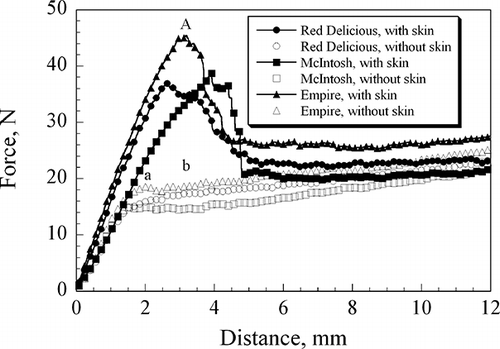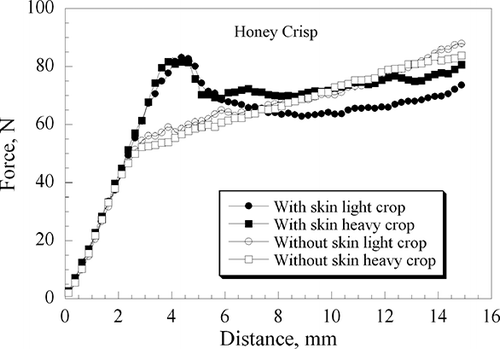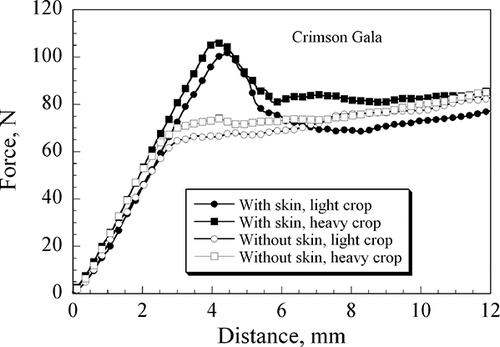Abstract
The modulus and breaking strength of the skins of different apples were measured: McIntosh, Red Delicious, and Empire stored under controlled atmosphere; McIntosh stored at 1.7°C without atmospheric control, and Honey Crisp and Crimson Gala grown under light and heavy crop conditions. The moduli of the skins of Honey Crisp and Crimson Gala were lower (P < 0.05), than those of Empire, McIntosh, and Red Delicious. Peak puncture force values of McIntosh, Red Delicious, and Empire were lower (P < 0.05) than those of Crimson Gala and Honey Crisp; the contribution of the skin of the Honey Crisp apples to the peak force was least among all the studied apples.
INTRODUCTION
The apple industry has evolved into an integrated system in which the production and storage sectors play important roles; further, to improve each sector, research is being conducted at institutions in several countries. Several apple cultivars have been developed for commerce, including: Crimson Gala, Empire, Honey Crisp, McIntosh, and Red Delicious. It is noted that the Honey Crisp apple is a relatively new cultivar that has a desirable crispy texture. The Crimson Gala is also a crispy, sweet apple, popularly used for snacking. Apples can be made to grow under different crop loads, such as light or heavy. For example,[Citation1] in the former, apples are removed allowing one apple per spur, and in the latter, no apples are removed. Most apple cultivars are stored over long periods of time under controlled atmosphere (CA), typically at: 1–3% O2 and 2–5% CO2, and 1.7°C.
Textural properties of skin (peel) and flesh of Golden Delicious apples were investigated during cold storage and ripening at room temperature by Grotte et al.[Citation2] Puncture tests were used to evaluate both skin and flesh for changes in deformation, failure load, and firmness during cold storage (2°C, 96% RH, 239 days) and ripening (20 ± 1°C, 28 days).[Citation2] During ripening, the contribution of the skin to changes in all the measured properties was found to be significant. Shafiee et al.[Citation3] also used puncture tests to find that the contribution of the skin of Golden Delicious apples was higher than that for Red Delicious apples. In addition, they reviewed studies on the role of skin on the texture of various fruits and vegetables.
Based on the high galacturonic acid levels resulting from acid hydrolysis, Arnous and Meyer[Citation4] noted that Red Delicious and Golden Delicious apple skins were dominated by complex pectin-containing structures; they also contained significant amounts of glucans. However, while Red Delicious apple skins also contained cyanidin-3-galactosides, phloridzin was detected only in Golden Delicious apple skin.
Because the skins of apples have been shown to play an important role in apple firmness,[Citation2,Citation3] their mechanical characteristics are of interest. Dynamic mechanical analyzers (DMAs) can be used to measure the rheological properties of solid foods in the linear and nonlinear viscoelastic regions. Based on the literature supplied by manufacturers of DMAs, Bu-Contreras and Rao[Citation5] summarized some of their salient features: the raw signals collected by a DMA are force and amplitude that can be converted to stress and strain, respectively. A DMA provides strong data collection capability during the experiments; for example, data can be collected in 3-sec intervals, which allow observation of rapidly occurring changes in the sample during the experiments.
The objectives of this investigation were: (1) to determine the modulus from stress-strain data of apple skin in tension and its breaking strength, and (2) to study the puncture force-deformation characteristics of apple slices with and without skin. The necessary tests were conducted to determine: (a) the moduli of the skins of McIntosh apples stored under CA and at 1.7°C without control of the atmosphere, and of Empire, McIntosh, and Red Delicious apples stored under CA; (b) the moduli of the skins of light and heavy crop Crimson Gala and Honey Crisp apples; and (c) the differences in the puncture force-penetration distance characteristics of apple slices with and without skin of the said apple cultivars.
MATERIALS AND METHODS
Materials
Apples grown for research on the orchards of New York State Agricultural Experiment Station (NYS AES) stored at 1.7°C and by a nearby commercial farm, Red Jacket Orchards and stored under CA (RJ-CA), were used in three sets of experiments:
| 1. | Tests with a DMA were conducted on the skins of the apples: McIntosh, NYS AES, harvested on September 14, 2001 and tested in May 2002; | ||||
| 2. | Tests with a DMA on the skins and puncture tests on slices were conducted on the apples: McIntosh, RJ-CA, harvested on September 15, 2001, tested in May 2002; Red Delicious, RJ-CA, harvested October 10, 2001, tested May 2002 and December 2002; and Empire RJ-CA, harvested October 2001, tested June 2002; and | ||||
| 3. | Tests with a DMA on the skins and puncture tests on slices were conducted on the apples: Honey Crisp, NYS AES, light and heavy crops, harvested on September 16, 2002; the heavy crop apples were tested on September 17, 2002 and the light crop apples on September 18, 2002; and Crimson Gala, NYS AES, light and heavy crops, harvested on September 16, 2002; the light crop apples were tested on September 19, 2002 and the heavy crop apples on September 20, 2002. | ||||
Because the studied apple varieties are of commercial interest in many temperate regions of the world, the results of this study should be of interest to many.
Tests with a Dynamic Mechanical Analyzer
The rheological characteristics of apple skin were determined with a DMA (Model 2980, TA Instruments, New Castle, DE, USA). The experiments were conducted in a temperature-controlled laboratory at 25 ± 1°C. From a slice of apple, the flesh was carefully removed with a sharp razor to produce a strip of skin about 18 mm long, 10 mm wide. The width, length, and thickness of each skin sample were measured with a digital caliper (Model pro-max 0-6, Fowler and NSK 74-200-777, Misumi Corp, Japan); the thickness of the strip was measured at four locations and an average value was calculated. Torque ranging between 0.005–0.05 Nm was used to secure the apple skin samples in the film clamp of the DMA. After the strip was held taut in the film clamp geometry of the DMA, continuously increasing tension (CIT) at 3 N min−1 was applied until the skin strip ruptured; in general, the rupture occurred after a strain 15%. Each CIT test was relatively quick to conduct and from the recorded force-deformation data values of an apparent modulus and breaking strength were determined. It is noted that values of the breaking strength indicated differences not clearly seen in the linear region.
Puncture Tests
Puncture tests were conducted with a cylindrical probe having a rounded end on slices of apple with and without skin using a Texture Analyzer (TA XT2; Texture Technologies Corporation, Scarsdale, NY, USA). A rounded end cylindrical probe, 7.9 mm diameter, built to be used with Magness-Taylor pressure tester was employed, at a crosshead speed of 50 mm/min to a depth of 15 mm; five puncture tests were conducted with skin and five tests without skin on slices of each apple cultivar. The puncture tests were conducted in a temperature-controlled laboratory at 25 ± 1°C after the apples, taken out of storage, reached the ambient temperature. Puncture force vs. penetration distance data were recorded as in Grotte et al.[Citation2] In addition, the maximum value (peak) of the puncture force indicated by the Texture Analyzer in each test was noted and an average value was calculated. Due to different values of the penetration distance recorded in each test on a slice of apple, it was not possible to calculate an average of the five force-distance curves. It should be noted that the values of force depend mostly on the diameter of the probe and the strength of the material being examined, and to a limited extent on the crosshead speed.
Data Analysis
Differences in the values of the various rheological parameters were evaluated by means of ANOVA using the data analysis software in Microsoft Office Excel 2007 (Microsoft Corp., Redmond, WA, USA); the differences were evaluated at the significance level P < 0.05.
RESULTS AND DISCUSSION
Skin Thickness
The measured values of skin thickness, mm, ranged from 0.20 ± 0.04 for cold stored McIntosh apples to 0.29 ± 0.01 for CA stored Red Delicious apples: McIntosh cold stored 0.20 ± 0.04, McIntosh CA stored 0.22 ± 0.04, Red Delicious CA stored 0.29 ± 0.01, Empire CA stored 0.25 ± 0.03, Crimson Gala light crop 0.26 ± 0.02, Crimson Gala heavy crop 0.28 ± 0.02, Honey Crisp light crop 0.28 ± 0.03, and Honey Crisp heavy crop 0.28 ± 0.04.
Results with a Dynamic Mechanical Analyzer
In , typical stress vs. strain data and their standard deviations are shown for the skin of a Red Delicious apple stored under CA. It is clear that the linear region exists up to about 4% strain; beyond that value, the stress response is nonlinear. It is noted that unlike with the small-amplitude oscillatory and stress relaxation tests, which are conducted in the linear viscoelastic range, the CIT test provides values of both an apparent modulus and the breaking strength. The modulus determined from the CIT test is referred to as an apparent modulus because the applied stress was not maintained constant for a reasonable length of time.
Figure 1 Typical stress-strain data and their standard deviations for the skin of a CA stored Red Delicious apple.

Several tests were conducted for each apple variety, from which the moduli and the breaking strength were calculated. contains the average values of the breaking strength and the apparent modulus of the skins of the apples: McIntosh, cold and CA, CA stored Red Delicious and Empire apples, Honey Crisp light and heavy crops, and Crimson Gala light and heavy crops. In , values with the same superscript are not significantly different (P ≥ 0.05).
Table 1 Values of breaking strength and apparent modulus of apples.Footnote a
The breaking strength of the skin of McIntosh, CA stored apples, 2.51 MPa, was higher than that of the cold temperature stored apples, 2.03 MPa; however, these values were not significantly different (P ≥ 0.05). The corresponding moduli showed an opposite trend: 26.2 MPa for the CA stored vs. 34.1 MPa for the cold temperature stored apples (). The modulus of the skin of cold-stored McIntosh apple was significantly higher (P < 0.05) than the moduli of the skins of the CA stored apples: McIntosh, Red Delicious, and Empire; however, the breaking strength was not significantly different (P ≥ 0.05).
Values of the moduli of the skins of CA stored McIntosh, Red Delicious, and Empire apples were not substantially different (): 26.2 MPa, 25.1 MPa, and 27.1 MPa, respectively. As seen with the stress-strain data of skins of CA stored Empire and McIntosh apples in , differences in the two sets of data are better discernible in the nonlinear range, especially near their breaking strength. Nevertheless, values of the breaking strength of the skins of the different apple cultivars were not significantly different (P ≥ 0.05).
The average values of the breaking strength and apparent modulus of the skins of light and heavy crop Honey Crisp and Crimson Gala apples are also shown in . There was no significant difference (P ≥ 0.05) in the values of skin modulus and breaking strength between the heavy and light crops of Crimson Gala and Honey Crisp apples. However, the moduli of the skins of the crispy apples, Honey Crisp and Crimson Gala, were significantly lower (P < 0.05) than the skins of the other apples, McIntosh, Red Delicious, and Empire.
Results of Puncture Tests
Typical puncture force vs. penetration distance plots of CA stored McIntosh, Red Delicious, and Empire apples with and without skin are shown in . It should be noted that without skin (open symbols), there is no sharp peak of the force. Also shown in for the data on Empire apples are the peak puncture force with skin, A; an assumed peak value without skin, b, at the same penetration distance at which with skin sample's peak force occurred; and the apparent elastic limit of the apple flesh without skin, a. The puncture force vs. penetration distance plots of Honey Crisp and Crimson Gala, heavy and light crop, are shown in and , respectively. It is noted that the force-deformation data shown in Figs. were selected for the purpose of illustration, but they are not averaged data. As explained earlier, it was not possible to calculate an average data set from the puncture force vs. penetration distance values generated in the five tests.
Figure 3 Puncture force vs. penetration distance plots of CA stored McIntosh, Red Delicious, and Empire apples with and without skin. Also shown are: the peak puncture force with skin, A, an assumed peak value without skin, b, at the same penetration distance at which with-skin sample's peak force occurred, and the apparent elastic limit of the apple flesh without skin, a.

In and also values of the puncture force with skin showed clear peaks, but those without skin did not show such peaks. The average values of the peak force of all the apples are given in ; they are the averages of the values recorded automatically by the texture analyzer in five tests and do not correspond to those shown in –. It is seen in , Crimson Gala heavy crop apples exhibited the highest puncture force.
Table 2 Peak puncture force, N, values with a rounded end cylindrical probe, 7.9 mm diameter
The peak force values of McIntosh, Red Delicious, and Empire apples with and without skin were significantly lower (P < 0.05) than those of Crimson Gala and Honey Crisp apples. There was no significant difference (P ≥ 0.05) in the values of the puncture force between the heavy and light crop Crimson Gala and Honey Crisp apples (). The contribution of the skin to the peak puncture force was calculated as:
An important result in is that the contribution of the skin of the Honey Crisp apples to the peak puncture force was lowest (P < 0.05) among the apples studied.
After the elastic limit, the puncture force values of all the apples without skins increased linearly with penetration distance (Figs. ). Linear equations were fitted, not shown here, to the linear segments of puncture force (y) vs. distance (x):
Compared to other apples, the flesh of Honey Crisp apples had a linear increase with the highest slope, while the flesh of Crimson Gala apples had the highest value of the intercept. Because values of the puncture force of the Honey Crisp heavy crop and the Crimson Gala heavy crop apples were similar in magnitudes to those of the light crop apples ( and ), separate linear equations were not fitted to their data.
CONCLUSIONS
Data obtained with a DMA showed that the apparent modulus of the skin of McIntosh apples stored at 1.7°C without control of atmosphere was higher than the moduli of the other apples. The apparent moduli of the skins of Honey Crisp and Crimson Gala apples were lower (P < 0.05) than those of the skins of Empire, McIntosh, and Red Delicious apples; however, values of their peak puncture force were significantly higher, P < 0.05. There was no significant difference (P ≥ 0.05) in the values of the peak puncture force between the heavy and light crop Crimson Gala and Honey Crisp apples. The contribution of the skin of the Honey Crisp apple to the peak puncture force was lower (P < 0.05) compared to that for the other apple varieties.
ACKNOWLEDGMENTS
The authors wish to thank H. Cooley for assistance with experiments and J. Barnard for checking the statistics.
REFERENCES
- Snyder-Leibyl , T.E. and Wang , S. 2008 . Role of crop load in chloroplast ultra-structure and zonal chlorosis, a physiological disorder in ‘Honeycrisp’ apple trees . HortScience , 43 ( 6 ) : 1819 – 1822 .
- Grotte , M. , Duprat , F. , Loonis , D. and Pietri , E. 2001 . Mechanical properties of the skin and the flesh of apples . International Journal of Food-Properties , 4 ( 1 ) : 149 – 161 .
- Shafiee , S. , Modares Motlagh , A. , Rahmani Didar , A. and Minaee , S. 2008 . Investigation of the effect of skin on mechanical behavior of apple . Journal of Food Technology , 6 ( 2 ) : 86 – 91 .
- Arnous , A. and Meyer , A.S. 2008 . Comparison of methods for compositional characterization of grape (Vitis vinifera L.) and apple (Malus domestica) skins . Food and Bioproducts Processing , 86 ( 2 ) : 79 – 86 .
- Bu-Contreras , R. and Rao , M.A. 2002 . Review: Dynamic rheological behavior of heated potatoes . Food Science and Technology International , 8 ( 1 ) : 3 – 10 .


